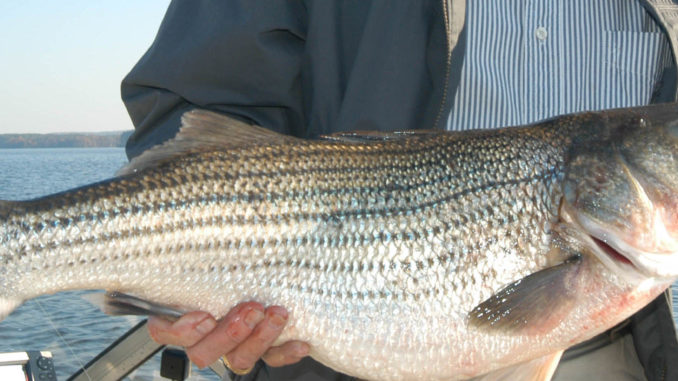
Pick a cloudy day, find sea gulls and hang on
Deer season is over, and hopefully, everybody has got plenty of venison in the freezer. Bass in South Carolina are usually lethargic this month; I usually wait until the first of February when we get a few warm fronts to start targeting them.
I get my January fill of fishing with striped bass. They’re a lot less lethargic than bass, and this month is my favorite time to fish for stripers. The schooling action is great; I love to catch them, I love to eat them, and it seems to me they taste better coming out of colder water.
When I go striper fishing, I really pay attention to two things, and both of them have to do with birds. First, there’s my Humminbird 1198 depthfinder unit, and second, there’s seagulls. They’ll show you where the bait is and where the fish usually are.
If you see birds diving, you know there is something going on; fish are pushing bait to the surface, and you’ll see some real action. But even if you don’t see birds diving, the places you see the most birds will be the places where the biggest concentrations of bait will be. Those birds will follow the big movements of the shad or herring up the rivers and into the creeks on our reservoirs. If you get in an area where there are a lot of birds, you’re in the right place.
If there’s no schooling and diving activity, I’ll work an area with my depthfinder and look for signs of bait and stripers. If you find them on your screen, you can bump a spoon off the bottom. This is the kind of action you get during mid-day; usually, you’ll have schooling activity early in the morning and late in the day — that’s when you see fish chasing bait to the surface. On low-pressure or cloudy days, you can see that kind of action throughout the day, so if you’ve got a choice and want to fish more than just a few hours early and late, try to pick one of those cloudy days.
When you’ve got fish on the surface, you can throw traditional topwater plugs at them, or you can catch them on soft-plastic swimbaits and jerkbaits, just casting into the breaking fish. When fish aren’t at the surface, that’s when your depthfinder is really important, because you’ve got to keep your bait at the same depth level with the baitfish and the stripers.
If I find bait and fish on or near the bottom, I’ll drop down a Hopkins spoon and jig it vertically. I’ll fish it on a 6-foot-6, medium-action All-Star baitcasting rod, using 17-pound Trilene XT mono. I don’t like to use braid unless I’m jigging in timber. And I don’t like a spoon with any hair or feathers tied in; I just want to jig a spoon with a hammered finish. The other thing I’ll do is fish a soft-plastic swimbait like a Storm Wild Eye Shad and bump it along the bottom. If the stripers are suspended under a school of suspended baitfish, I think I can count that bait down and just swim it along at the depth the stripers are and keep it in front of them as long as I can.
How bait a bait I’ll use depends on how deep they are. I’ll have a ¾-ounce bait tied on for when they’re 30 feet deep over 40 feet of water, and I’ll have a 3/8-ounce bait tied on if they’re in 15 feet of water over a 30-foot deep bottom. When I cast and the bait hits the water, I count it down about a foot a second until I think I’ve got it in the strike zone. I’ll fish that swimbait on a 7-foot-2 All-Star swimbait rod, and I’ll have Trilene 100 Percent Fluorocarbon spooled on the reel.
The nice thing about stripers is that they’re aggressive. They don’t feed all the time, but they’re more aggressive. They’re naturally a saltwater fish, and about all they do is swim and eat. Get a bait in front of them, and most of the time, they’ll bite.
And that’s one great thing about stripers. Get in the right area, present your lure the right way, and you’ll have a great January outing.






Be the first to comment